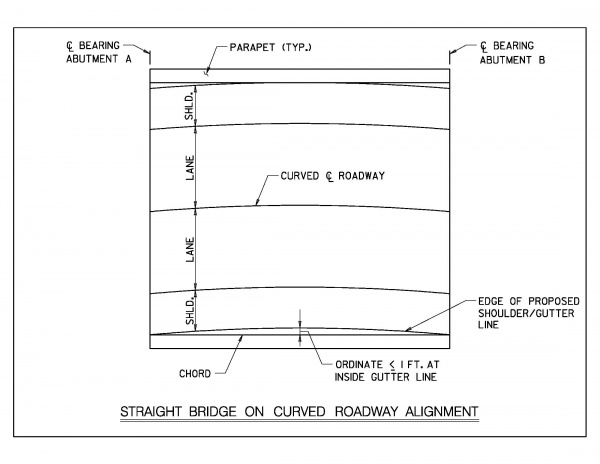Bridge: Stream Crossings
|
Stream Crossings | ||
ContentsPrimary Guidance
| ||
DiscussionCurved Horizontal AlignmentsIf possible, avoid locating bridges on curved horizontal alignments, since curved structures are more expensive to fabricate and are more difficult to construct than straight structures. If a bridge falls within a curved roadway alignment, see if a tangent (straight) section can be introduced into the curve that encompasses the bridge limits. If the curve radius is large enough, consider constructing the bridge with straight girders and deck and variable width shoulders. To determine if this is feasible, determine the ordinate between the inside curve gutter line and the chord created by connecting the gutter line location at the bearing center line at each abutment. If this value is less than 1 ft. 0 inches, the structure should be laid out with straight girders and deck.Cross SlopesThe preferred minimum cross slope on a bridge deck is 2 percent, which will facilitate travel lanes drainage and help avoid an icy bridge deck. Constant cross slopes are preferred across the entire bridge length to reduce complex deck construction operations. It is possible to accommodate transitional cross slopes in a bridge deck; however, the transition from normal crown (2 percent in each direction from the crown) to plane incline requires a longitudinal joint at the crown/pivot point and complicated camber in the girders to account for the unusual deflections that will occur. It is also possible to have transitioning superelevation across a bridge, which would occur if it was in a reverse curve. This should be avoided when possible, since it will result in a flat area on the deck when the superelevation is 0 percent, which does not facilitate the travel lanes water drainage and can lead to safety and maintenance issues. If it is not possible to adjust the alignment so the bridge is not within the area of transitioning superelevation, scuppers should be placed on either side the flat area to capture bridge deck drainage before it reaches this point. Sumps in Roadway ProfileBridges should not be located in a sump (low point) in the roadway profile. Bridge deck sumps will result in an area where water will collect and can lead to safety and maintenance issues. Even when the sump is moved off the bridge, the roadway elevations should be checked to ensure the bridge deck is not essentially flat as you approach the sump. If it is not possible to avoid a bridge sump, scuppers should be placed at and on either side of the sump to ensure sufficient drainage. |
